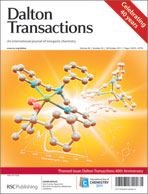This month sees the following articles in Dalton Transactions that are in the top ten most accessed:-
The future of metal–organic frameworks
Neil R. Champness
Dalton Trans., 2011, 40, 10311-10315 DOI: 10.1039/C1DT11184A
Chiral salen-metal derivatives of polyoxometalates with asymmetric catalytic and photocatalytic activities
Xing Meng, Chao Qin, Xin-Long Wang, Zhong-Min Su, Bo Li and Qi-Hua Yang
Dalton Trans., 2011, 40, 9964-9966 DOI: 10.1039/C1DT11227A
Unprecedented heptacopper(ii) cluster with body-centred anti-prismatic topology. Structure, magnetism and density functional study
Himanshu Arora, Joan Cano, Francesc Lloret and Rabindranath Mukherjee
Dalton Trans., 2011, 40, 10055-10062 DOI: 10.1039/C1DT11119A
Two novel Dy8 and Dy11 clusters with cubane [Dy4(µ3-OH)4]8+ units exhibiting slow magnetic relaxation behaviour
Yan-Li Miao, Jun-Liang Liu, Jin-Yan Li, Ji-Dong Leng, Yong-Cong Ou and Ming-Liang Tong
Dalton Trans., 2011, 40, 10229-10236 DOI: 10.1039/C1DT10613A
Encapsulation of trivalent phosphate anion within a rigidified p-stacked dimeric capsular assembly of tripodal receptor
Sandeep Kumar Dey and Gopal Das
Dalton Trans., 2011, Advance Article DOI: 10.1039/C1DT11195G
Coordinating ability of anions and solvents towards transition metals and lanthanides
Raúl Díaz-Torres and Santiago Alvarez
Dalton Trans., 2011, 40, 10742-10750 DOI: 10.1039/C1DT11000D
Synthesis and complexes of an N4 Schiff-base macrocycle derived from 2,2′-iminobisbenzaldehyde
Rajni Sanyal, Scott A. Cameron and Sally Brooker
Dalton Trans., 2011, Advance Article DOI: 10.1039/C1DT10730E
A sixfold interpenetrated microporous MOF constructed from heterometallic tetranuclear cluster exhibiting selective gas adsorption
Yun-Wu Li, Li-Fu Wang, Kun-Huan He, Qiang Chen and Xian-He Bu
Dalton Trans., 2011, 40, 10319-10321 DOI: 10.1039/C1DT10554J
A family of 13 tetranuclear zinc(ii)-lanthanide(iii) complexes of a [3 + 3] Schiff-base macrocycle derived from 1,4-diformyl-2,3-dihydroxybenzene
Humphrey L. C. Feltham, Frederik Klöwer, Scott A. Cameron, David S. Larsen, Yanhua Lan, Manuel Tropiano, Stephen Faulkner, Annie K. Powell and Sally Brooker
Dalton Trans., 2011, Advance Article DOI: 10.1039/C1DT11038A
CoII, MnII and CuII-directed coordination polymers with mixed tetrazolate–dicarboxylate heterobridges exhibiting spin-canted, spin-frustrated antiferromagnetism and a slight spin-flop transition
En-Cui Yang, Zhong-Yi Liu, Xiao-Yun Wu, Hong Chang, En-Chan Wang and Xiao-Jun Zhao
Dalton Trans., 2011, 40, 10082-10089 DOI: 10.1039/C1DT10958H
Why not take a look at the articles today and blog your thoughts and comments below.
Fancy submitting an article to Dalton Transactions? Then why not submit to us today or alternatively email us your suggestions.











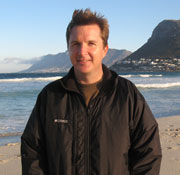
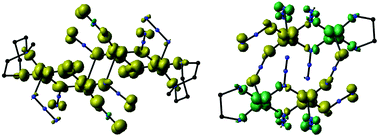 This HOT article by Mukherjee et al. reports the synthesis, structure, magnetic properties and DFT studies of four Cu(II)-azide polymers. Cu(II)-azide polymers are presently being studied by many groups due to their interesting structural variation and magnetic properties. In this paper, three out of the four compounds studied are of new structural topologies. All four complexes exhibit an overall ferromagnetic behaviour; the magnetic results are corroborated by DFT studies. The structural analysis shows how a simple change in the structure of the blocking ligand can generate entirely different structures and magnetic properties, even though the basic structures seems to be almost identical. It is also shown that another blocking diamine does not produce similar complexes under the same reaction conditions, which leads to the question: are certain compositions forbidden?
This HOT article by Mukherjee et al. reports the synthesis, structure, magnetic properties and DFT studies of four Cu(II)-azide polymers. Cu(II)-azide polymers are presently being studied by many groups due to their interesting structural variation and magnetic properties. In this paper, three out of the four compounds studied are of new structural topologies. All four complexes exhibit an overall ferromagnetic behaviour; the magnetic results are corroborated by DFT studies. The structural analysis shows how a simple change in the structure of the blocking ligand can generate entirely different structures and magnetic properties, even though the basic structures seems to be almost identical. It is also shown that another blocking diamine does not produce similar complexes under the same reaction conditions, which leads to the question: are certain compositions forbidden?





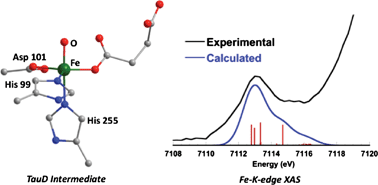 and Serena DeBeer (Cornell University), predict iron K-edge XAS pre-edge features for iron complexes using time-dependent density functional theory in this Dalton Transactions Hot article.
and Serena DeBeer (Cornell University), predict iron K-edge XAS pre-edge features for iron complexes using time-dependent density functional theory in this Dalton Transactions Hot article.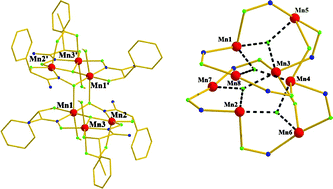 In this HOT article, Constantinos J. Milios and co-workers describe the synthesis, crystal structures and magnetic properties of (a hexanuclear and an octanuclear) manganese(III) complexes based on a new oxime ligand, 2-dihydroxy-2-phenylacetamidine. This is the first time that this ligand has been used for the synthesis of polynuclear complexes of any transition metal ion. Even though the hexanuclear complex resembles the previously reported [Mn6] clusters with salicyl-based oximes, the octanuclear complex presents a new structural type in Mn chemistry. Both complexes display moderate spin ground states (S = 3). The authors believe this new ligand is a promising candidate for a new extended family of manganese complexes with interesting magnetic properties and as impressive structures as its parent salicyl- or pyridyl-based oxime ligands.
In this HOT article, Constantinos J. Milios and co-workers describe the synthesis, crystal structures and magnetic properties of (a hexanuclear and an octanuclear) manganese(III) complexes based on a new oxime ligand, 2-dihydroxy-2-phenylacetamidine. This is the first time that this ligand has been used for the synthesis of polynuclear complexes of any transition metal ion. Even though the hexanuclear complex resembles the previously reported [Mn6] clusters with salicyl-based oximes, the octanuclear complex presents a new structural type in Mn chemistry. Both complexes display moderate spin ground states (S = 3). The authors believe this new ligand is a promising candidate for a new extended family of manganese complexes with interesting magnetic properties and as impressive structures as its parent salicyl- or pyridyl-based oxime ligands.